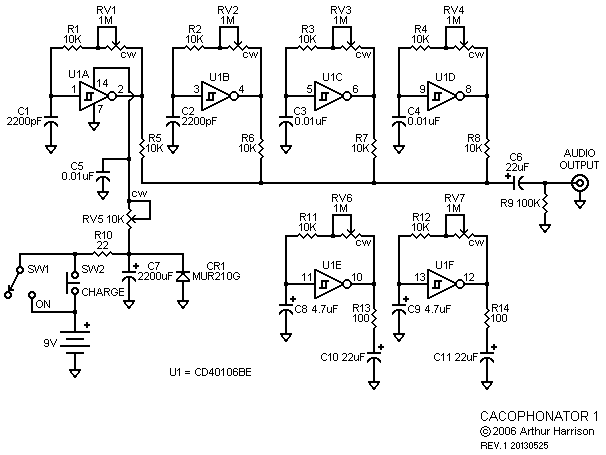
Cacophonator
| NOTICE: Unless specifically stated
in a written contract, Arthur Harrison grants no licence to any party for the use of the content in this site for the manufacture and sale of goods, nor any other commercial utilization. Refer licensing inquiries to: diy@harrisoninstruments.com. |
In the summer of 2006, Kevin Buckholdt and I designed and evaluated a number of circuits, with the goal of producing complex sonic effects with few components. In naming our project, we derived the term "Cacophonator," for cacophony plus oscillator.
The circuit illustrated below consists of a single CMOS (Complimentary Metal Oxide Semiconductor) integrated circuit (U1) with six identical sections, each one an inverting Schmitt trigger. All six sections share the same power supply, connected at pin 14. Each section is configured as a relaxation oscillator in which the hysteretic properties of the inverting Schmitt trigger, in conjunction with a feedback resistor and delay capacitor (e.g., R1+RV1 and C1), produce six unique squarewaves at each of the inverting Schmitt trigger outputs.

Cacophonator 1
As the value of RV5 is increased, each oscillator increasingly contributes to, and is increasingly susceptible to, power-supply-voltage changes. The power supply node (U1 pin 14), therefore, serves as a common point at which each of the six oscillators affect each other. Oscillators U1A through U1D also affect each other through their output resistors, R5 through R8. The outputs of the two low-frequency oscillators, LF1 and LF2, are not summed with the others, but rather, drive large capacitive loads, C10 and C11, via small-value resistors R13 and R14, respectively. The objective of these two oscillators is to introduce power-supply voltage perturbations each time their respective load capacitors are charged and discharged. RV5 controls the effective impedance of the power supply, and therefore, the amplitude of these perturbations.
In conventional applications, adequate supply decoupling and a current summing node at the R5-R8 output bus would be used to prevent interaction among the oscillators. In this circuit, however, RV5 permits the user to increase the power supply impedance intentionally, and therefore the degree of interaction.
It is interesting to study the effects obtained when RV5 is moved toward the clockwise extreme. In doing so, the prevailing function of the circuit changes from a deterministic to stochastic mode, increasingly difficult to predict and complex in behavior. While such unpredictable behaviour is a detriment to utilitarian designs, it is of value in producing cacophony.
The circuit's oscillator characteristics are summarized below:
| Oscillator | IC Section |
Frequency Range |
Control |
HF1 |
A |
800Hz to 70kHz | RV1 |
HF2 |
B |
800Hz to 70kHz | RV2 |
MF1 |
C |
160Hz to 15kHz | RV3 |
MF2 |
D |
160Hz to 15kHz | RV4 |
LF1 |
E |
0.3Hz to 33Hz | RV6 |
LF2 |
F |
0.3Hz to 33Hz | RV7 |
Momentary switch SW2 is provided to rapidly charge C7, which then discharges slowly into the circuit. In this mode, C7's diminishing voltage, in conjunction with a resistance selected with RV5, provides myriad interesting sonic effects for a period of several minutes. Note that the discharge period for C7 is affected by the load at the audio output, which should therefore be a high impedance in order to obtain this period. SW1 is provided for direct battery-voltage operation without the effects of C7's discharge. R10 serves to protect the switch contacts from C7's low initial impedance. CR1 protects the circuit from inadvertent battery reversal.
The six potentiometers in the oscillator sections, RV1, RV2, RV3, RV4, RV6, and RV7, may be linear-taper types.
Cacophonator 1 produces surprisingly elaborate sonic results, despite the fact that it uses only a single, inexpensive integrated circuit, and relatively few additional components. An audio example, using the circuit in the C7-discharge mode, is provided here. A comprehensive example of the Cacophonator is presented by The Mirlitrons, in their composition, "LyfeTyme."
March 30, 2006
Updated August 10, 2013
Text and images ©2006, 2013 by Arthur Harrison
Back to the Circuit Library Index
Back to the Opening Page of Art's Theremin Page